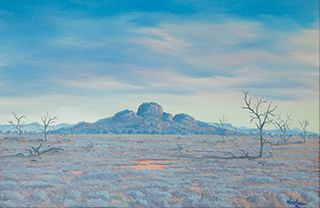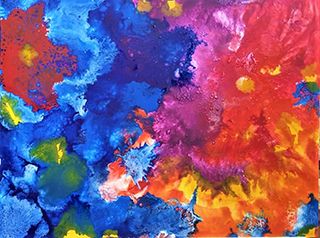September 2021 Mailbag No 2
The first item in September Mailbag No 2 is from Andrew from the Hunter Valley who shares two of his paintings done by Jack Absalom. Jack was one of the Brushmen of the Bush we have frequently written about.
"Pintabee Rock" (below left) 40 x 61 dated 1984 purchased March 1985 from Jack at his Absalom Gallery Broken Hill. Jack was a true character in every sense of the word: he could talk about anything, politics, religion, art, Australia, the desert and its people. Not only could he talk about these topics he, I'm sure, could have done it under water- as I said a real character... a raconteur. I also have a series of DVDs put out by Jack on how to survive in the desert, but also showing painting his landscapes outdoors.
Night Camp ( Nocturne)(below right) 24 x 37 dated 1986 purchased March 1986 from Brighton Galleries, Sydney.


Rowdy Wylie writes about...
An amazing painting “Waiting for Bumper Harvest” by Tendai Makufa from Africa…. I really like Tendai’s colourful paintings and your recent post explained Tendai’s magnificent composition in exceptional detail i.e. …. “the four essential elements”…the “narrative”….”colours” ….. “shape” ….. and “pattern”…… your description of Tendai’s work is so informative and in closing… the post highlighted the compositions….. rhythm of the workers…..bursting into song and activity when the crops are ready to harvest….. magnificent work by Tendai & a tremendous post…. JW
Rowdy continues:
P.S. Tendai appears to disguise the workers in the fields amongst the “crops” & by doing so encourages the viewer to look “deeply” into the composition to find & count the people….tremendous creativity…. with this creation of “intrigue” it reminds me of “Master Artist” Hugh Schultz…. disguising emus and kangaroos in the Australian bush!!!! Tremendous!!!
To illustrate Rowdy's point here is a Hugh Schulz painting - Old Grazing Property out West 1995 Oil on board and Tendai's Waiting for Bumper Harvest. Both artists have used the technique of melding the subjects into the composition so that they blend into their natural environment. The women working in the field in Tendai's painting and the animals in the painting by Hugh Schulz. I found four different kinds of creatures in Hugh's painting - can you? And I think there are at least eight women in Tendia's work.


From Rowdy Wylie -
Hello Anne…. A very big congratulations to you and Jane…on your recent posts about the Tokyo Olympic Games and the Paralympic Games... in a time of immense challenges… with the world consumed by Covid…. during 2020 and 2021….
I really enjoyed Jane’s post about the history of the Olympic Games and in ancient times athletes were rewarded for their individual and team efforts for winning events with “Olive Wreaths”…regarded as very prestigious… then when the "Games" were “reborn” in 1896 medals were introduced… an amazing story!!
But…. most interestingly was the Japanese “recycling” initiative and contribution to the world games. The Japanese Citizens donated “tons” of their pre-used electronic items to be “melted down” and “forged” towards sustainable Awards…. A tremendous outcome and Japanese initiative for the world environment!!..…
Following on… Anne celebrated the ”Paralympians” and highlighted the individual competitor's strengths in over coming “huge life barriers” and the challenge of “disability” (Ability!!!) to achieve exceptional “greatness” at their top sporting level and become “World Master Athletes”!!!…. Watching the Athletes compete at the “Paralympics” is so inspiring and to see the “emotion of determination” on their faces during the event and after they have completed their event and “given it their all”…. is absolutely “Out of this World”!!!!....... What an achievement!!!... Thankyou….. Anne & Jane for your amazing Posts….. John
And thank you John for your comments and praise which we love reading. And lots of people enjoyed the boab posts which you wrote with me. Jane shared a couple of photos of boabs in Western Australia.

M. in Wheelers Hill sent in this video which shows the works of toothpick sculpture Scott Weaver. Scott Weaver's family has lived in San Francisco for 3 generations. Scott started building toothpick sculptures in 1968, when he was 8 years old.He has an amzing collection even to one that fits on his head!!!
Early structures were abstract and about 2–4 feet tall. Then he built one sculpture that had a ping-pong ball roll through it. In 1974, Scott started a new sculpture and added the Golden Gate Bridge and Lombard Street, which also had a ping-pong ball roll through it. This is what started what is now Rolling Through the Bay. Over the years Scott has worked on Rolling Through the Bay, on-and-off, sometimes not working on it for years at a time, to do other projects and get married to his beautiful wife, Rochelle, and have a wonderful son, Tyler. Scott loves working with toothpicks and hopes to do so for years to come. 4

Watch the video to see what Scott has done in 37 years with 105,387 toothpicks - especially his creation Rolling Through the Bay.
And to conclude I would like to introduce you to Antonio Garcia who has joined our AnArt4Life Facebook ChatRoom. Antonio's abstract paintings come alive and dance across the field in colour.



Credits
1. From the collection of Andrew from the Hunter Valley
2. facebook.com/tendai.makufa
3. Image provided by the Broken Hill Regional Art Gallery.
4. exploratorium.edu/tinkering/tinkerers/scott-weaver
5. exploratorium.edu/
6. facebook.com
